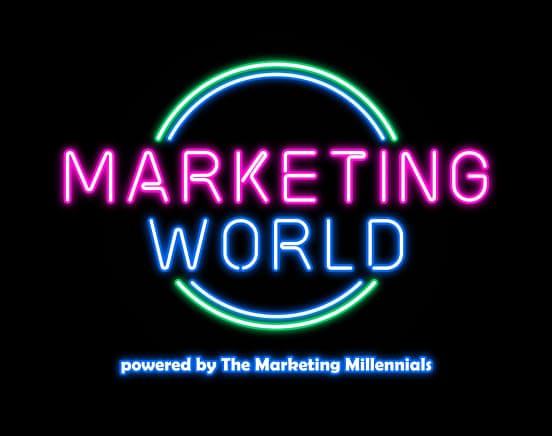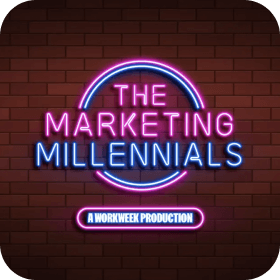I’m so excited to share my conversation with Matthew Kobach!
He’s the CMO of Northbeam, a third-party attribution tool for e-comm brands. Before this, he worked at Fast and the New York Stock Exchange.
One thing that I notice everywhere he goes: a Twitter strategy that makes WAVES.
(Remember when everyoneeee was tweeting pics of their Fast hoodies?)
His personal Twitter might be the most — he started it in 2019, and now 135K+ people follow him.
I’ve learned a lot from him about life AND marketing. His old Twitter bio was “Life advice disguised as marketing advice,” and that still feels true.
Now you all can learn from him, too.
Here are Matthew’s hottest takes from our jam session on the Marketing Millennials podcast, in his own (lightly-edited) words.
1. How to start from scratch on Twitter:
In 2019, I decided, “I want to see if I can take what I know that works for branded social media marketing and apply it to my own personal social media.”
I was going to post 2X a day for 6 months, MINIMUM.
I do it first thing when I wake up and when I get home from work. If I want to post more, I can.
I started by saying things about social media marketing. Things that people who had done it for a long time understood to be true, but hadn’t necessarily articulated.
I also poked holes through some old theories about social media.
Everyone kind of agreed, but no one was saying it.
I was able to be the person saying these things that people felt and knew to be true. It reaffirmed what they thought.
2. Why Twitter > Instagram:
I focus on Twitter because it’s where the bar to entry is the lowest in terms of content. It’s just words. It’s just ideas.
Level up your marketing game
Zero BS. Just fun, unfiltered, industry insights with the game-changers behind some of the coolest companies from around the globe.
No spam. Unsubscribe any time.
You don’t have to be a great photographer. You don’t have to do graphic design or edit video.
I wanted to share the way that I was thinking.
Twitter was the platform that most easily allowed that.
Also, I wanted to only invest in one platform at the jump. I didn’t want spread myself too thin.
It’s been successful. I’ve taken some of stuff and applied it to LinkedIn, to Instagram, but still Twitter’s the one that I spend the most time on.
3. How Matthew’s tweeting workflow works:
There’s two ways that I write.
Either something pops into my head and I feel like tweeting it right then — or I post an old draft.
I could probably not write another tweet and be good for the next 12 months.
I have so many drafts. HUNDREDS.
There is a reason why some of them aren’t published, but some of them are full-fledged ideas.
There are times where I read a book or go for a walk or inspiration hits, and I could write 10 posts all within 15 minutes.
But you don’t want to push all that out there. Cause it might take me 3 or 4 days before something close as good as any of those hits me again.
So I write in batches and in waves.
I don’t schedule posts.
You never know what’s going to happen. You could have a monumental national event that makes your post look kind of weird or out of touch.
I post in real time.
4. How to (and NOT to) build a social audience:
There’s no RIGHT or WRONG way to use social media. It’s fine if you want to use your social media as a diary.
But there are better and worse ways to use social media if you want to build an engaged audience.
You’ve got to figure out, “Is what I’m posting going to make someone’s news feed better?”
It’s this idea of adding value. You can add value through…
Art
Comedy
InformationAnd you have to add value kind of in a very similar way each post. If I’m gonna add value by posting a nature photo, I need to stick to that niche and have a lot of photos of nature.
If all of a sudden I throw in what I ate that day, it’s gonna be an odd piece of content within my established brand.
Add value and stay very specific to the value.
5. Why social KPIs suck:
I hate KPIs. Well, I shouldn’t say that. But I feel like they’ve been glorified too much in the age of digital marketing.
It’s really easy to say “I ran this ad on Facebook and it got this many clicks and converted this many people.”
I’ve got nothing against that stuff, but there are some marketing efforts that are just squishier.
What you really want to optimize for you can’t put in a quantitative form.
Like, I don’t know how to put in a quantitative form “People want our merch.”
I could say 30 people ask today, the next day 20 people ask — it doesn’t really mean anything.
Butt it seems good when people are excited to wear a brand out in public.
Obviously I’m looking at our numbers, whether our social media is growing, our engagement’s high, our impressions are good.
But it ends up being as much gut as it is hard numbers.
Want The Marketing Millennials in your inbox? Subscribe to the newsletter.



